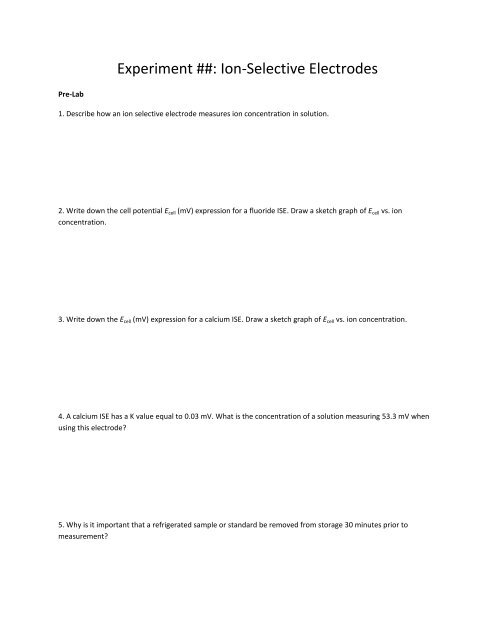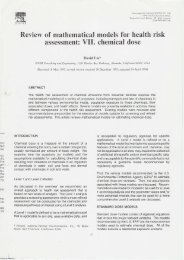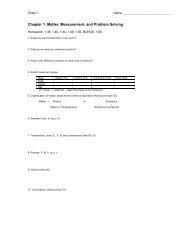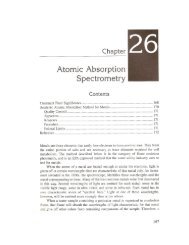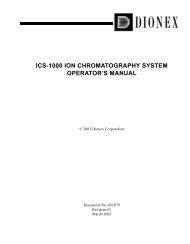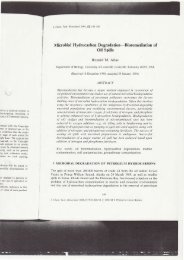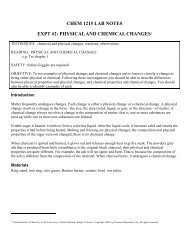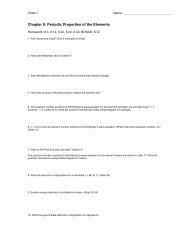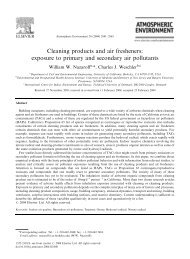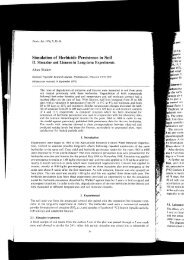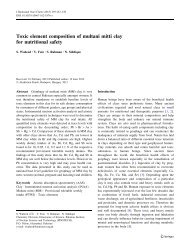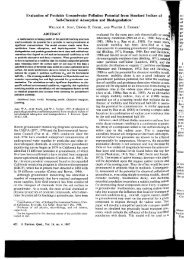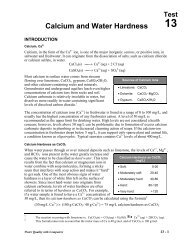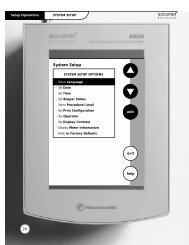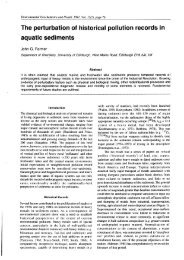Experiment ##: Ion-Selective Electrodes
Experiment ##: Ion-Selective Electrodes
Experiment ##: Ion-Selective Electrodes
Create successful ePaper yourself
Turn your PDF publications into a flip-book with our unique Google optimized e-Paper software.
<strong>Experiment</strong> <strong>##</strong>: <strong>Ion</strong>-<strong>Selective</strong> <strong>Electrodes</strong><br />
Pre-Lab<br />
1. Describe how an ion selective electrode measures ion concentration in solution.<br />
2. Write down the cell potential E cell (mV) expression for a fluoride ISE. Draw a sketch graph of E cell vs. ion<br />
concentration.<br />
3. Write down the E cell (mV) expression for a calcium ISE. Draw a sketch graph of E cell vs. ion concentration.<br />
4. A calcium ISE has a K value equal to 0.03 mV. What is the concentration of a solution measuring 53.3 mV when<br />
using this electrode?<br />
5. Why is it important that a refrigerated sample or standard be removed from storage 30 minutes prior to<br />
measurement?
<strong>Experiment</strong> <strong>##</strong>: <strong>Ion</strong>-<strong>Selective</strong> <strong>Electrodes</strong><br />
Theory<br />
An ISE consists of a ‘sensing’ halfcell consisting of a polymer, crystalline or glass membrane (Table X.X). The most<br />
commonly used ISE is the pH probe which uses a glass membrane. Polymer membranes are coated with an organic<br />
molecule that selectively absorbs the ion being measured. Crystalline membranes contain crystal lattice holes<br />
generated with an impurity through which ions may selectively pass [1, 2, 3]. Both types also contain a ‘reference’<br />
halfcell.<br />
Polymer membrane Ca 2+ , BF 4 - , NO 3 - , ClO 4 - , K + , Mg 2+<br />
Crystalline membrane Br - , Cd 2+ , Cl - , Cu 2+ , F - , I - , Pb 2+ , Ag/S 2- , SCN -<br />
Glass membrane H + , Na + , Ag + , Pb 2+ , Cd 2+<br />
Table X.X.: Polymer, crystalline and glass ISEs.<br />
The potential difference generated between the sensing electrode and the reference electrode is proportional to<br />
the ions concentration.<br />
The ions concentration generates a potential E (mV) according to the Nernst equation:<br />
E cell = E 0 + 2.303 RT log C<br />
nF<br />
Where R = gas constant = 8.316 J mol -1 K -1 , T = temperature (K), n = charge on the analyte ion, F = Faraday’s<br />
constant = 96487 C eq -1 , and C = concentration of ion. This simplifies to:<br />
E cell = K + 59.2 log [M n+ ]<br />
n<br />
And, E cell = K - 59.2 log [A n- ]<br />
n<br />
Where E = potential (mV), M = metal element, A = non-metal element, n = integer charge, K = constant. This<br />
equation conforms to the standard equation for a line ‘y = mx + b’ with slope (m) = ± 59.2/n and intercept (b) = K.
Fig. X.X: Components of a typical <strong>Ion</strong>-<strong>Selective</strong> Electrode.<br />
<strong>Ion</strong>ic Strength Adjuster (ISA): It is likely that samples will be higher ionic strength than standards. Variable ionic<br />
strength of solutions varies electrode response; also the calibration curve is affected. ISA adds ionic strength (it<br />
does not add ion under study). ISA swamps ionic effects of host solutions and gives uniform ionic strength in all<br />
solutions. Calcium ISA does not buffer a solution or complex interfering ions like fluoride ISA. Fluoride ISA buffers<br />
to a much narrower range (pH 5.2 to 5.7) which reduces interference from OH- and formation of toxic HF. Fluoride<br />
ISA also complexes Al 3+ and M 2+ with citrate. These metal ions would otherwise bind with F - too strongly for it to be<br />
measured correctly.
<strong>Experiment</strong> <strong>##</strong>: <strong>Ion</strong> <strong>Selective</strong> <strong>Electrodes</strong><br />
Objective<br />
To use an ion selective electrode to measure the concentration of an ion in solution.<br />
Apparatus<br />
An electrode, an output device, ionic strength adjuster and ion standards.<br />
Method<br />
1. Set up electrode and allow to equilibrate in high concentration standard (~30 mins). The pH range for most ISEs<br />
is 3-10. Neutralize samples outside this range to bring them in range.<br />
2. Samples and standards should be at the same temperature for precise measurement. Make up standards of 1,<br />
10, 100, 1000 ppm. Add 2mL of ISA per 100 mL of standard.<br />
3. Analyze with ISA from low to high (0.1, 1, 10, 100, 1000 ppm). Be sure that the ISE is not resting on the bottom<br />
of the sample. Agitate samples whilst measuring them, this supplies a constant flow of ions to the sensor. Hold the<br />
ISE and wait approximately 30 seconds for the voltage reading to stabilize. Rinse the ISE thoroughly with DI water<br />
and shake off excess solution, do not ever touch the membrane it is very fragile.<br />
(Note: if the voltage reading fluctuates, calculate the mean value.)<br />
4. Construct a calibration curve of E cell (mV) vs. log C (where C = [M n+ ] or [A n- ]), ensure that the slope is at or near<br />
59.2/n (± 2 mV).<br />
5. Analyze unknown water samples and use the calibration curve to calculate the ion concentration (mg/L).<br />
6. For the calcium ion calculate the concentration of samples in ppm CaCO 3 .<br />
Calcium hardness as CaCO 3 (ppm CaCO 3 ) = 2.5 x [Ca 2+ ]<br />
7. Store ISEs in dilute ISA solution. For short periods in between use ISEs are best stored moist. Dry before storing<br />
for long periods of time.
Results<br />
Standard<br />
Concentration<br />
(ppm)<br />
Potential (mV)<br />
Sample ID Potential (mV) [ ____ ] (ppm) Notes
Calibration Curve<br />
Conclusion<br />
1. Discuss the sample ion concentrations, are they as expected?<br />
2. What kind of ion concentration values could you use for comparison?<br />
3. How many ISE readings of a single sample should you take in order to improve accuracy?<br />
4. Describe what you would look for on an ISE calibration curve in order to assess whether an ISE is<br />
faulty or in need of repair.
References<br />
[1] Frank and Ross (1966) Electrode for Sensing Fluoride <strong>Ion</strong> Activity in Solution. Science, Vol. 154,<br />
pp.1553.<br />
[2] Frant, MS. (1994) History of the Early Commercialization of <strong>Ion</strong>-<strong>Selective</strong> <strong>Electrodes</strong>. Analyst, Vol.<br />
199, pp. 2293-2301.<br />
[3] Meyerhoff, ME and Opdycke, W.N. (1986) <strong>Ion</strong> <strong>Selective</strong> <strong>Electrodes</strong>. Advances in Clinical Chemistry,<br />
Vol. 25, pp. 1-47.


